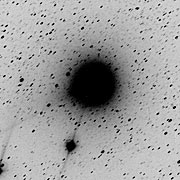Lehdistötiedote
First ESO Image of New Comet 1998 P1
12. elokuuta 1998
A new comet was discovered on August 10 by amateur astronomer Peter Williams of Heathcote (near Sydney, Australia). Having received information about this, other observers on that continent sighted the new object yesterday, August 11.
Official announcement of this discovery was sent yesterday evening to all observatories by the IAU Central Bureau for Astronomical Telegrams on IAU Circular no. 6986. The comet, provisionally designated as C/1998 P1, is seen in the southern constellation Circinus (The Compass) and the magnitude is estimated at about 9.5. This corresponds to about 25 times fainter than what can be seen with the unaided eye. The comet is easily visible in small telescopes. The orbit (and therefore the current distance) is not yet known.
Observations of the new comet were made with the 1.54-m Danish Telescope at the ESO La Silla observatory, immediately in the evening of August 11. The observers were Hans Kjeldsen (Theoretical Astrophysics Centre, University of Aarhus, Denmark) and Hermann Boehnhardt (ESO La Silla, Chile).
The images shown here (in positive and negative) have been reproduced from a 2-min exposure with the DFOSC instrument through a B (blue) filter on August 11, at 23:40 UT.
The coma diameter is at least 6 arcmin and is almost spherical, with a slight asymmetry on the tailside. A very thin and quite faint plasma-tail points in the lower left direction (position angle = 117° = "8 o'clock"), which is most likely close to the radial direction opposite to the Sun (but this can only be confirmed when a first orbit has been computed). The visible plasma tail extends at least 6.5 arcmin (beyond the field of view) and is produced by the emission of light from CO + (carbon monoxide ions) originating from sublimating ice of the cometary nucleus. The presence of this tail indicates that the comet is probably less than 1.5 AU (about 225 million km) from the Sun.
At the time of the ESO observation, the comet was seen in the southern Milky Way band. The sky field thus contains many background stars whose images are somewhat trailed because the telescope was set to follow the motion of the comet. Straylight (reflections in the telescope optics) from two bright stars, one to the lower left of the comet and the other one just beyond the lower left corner of the frame, cause bright extensions in the SSE - NNW direction.
Tiedotteesta
| Tiedote nr.: | eso9838 |
| Legacy ID: | Photo 31/98 |
| Nimi: | Comet 1998 P1 |
| Tyyppi: | Solar System Solar System : Interplanetary Body : Comet |
| Facility: | Danish 1.54-metre telescope |
| Instruments: | DFOSC |


